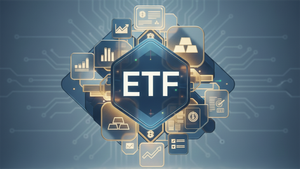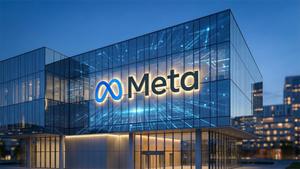Financial News
Blockchain's Quiet Revolution: Beyond Crypto, A New Digital Foundation Emerges

Blockchain technology, once primarily associated with volatile cryptocurrencies, is undergoing a profound and quiet revolution, steadily transforming into a foundational layer for a myriad of industries. This evolution marks a significant shift from speculative digital assets to practical, enterprise-grade solutions, promising unprecedented levels of transparency, security, and efficiency across global supply chains, digital identity, and decentralized governance. The immediate implications are far-reaching, signaling a future where trust is embedded in digital interactions, and traditional intermediaries are increasingly disintermediated.
This maturation of blockchain is not merely an incremental improvement but a fundamental re-architecture of how data is managed, transactions are executed, and organizations operate. Businesses and governments worldwide are now actively exploring and implementing blockchain solutions, recognizing its potential to streamline operations, reduce costs, and unlock new economic models. The shift is poised to redefine competitive landscapes and create new opportunities for innovation in the digital economy.
The Unfolding Tapestry of Blockchain Innovation
The current wave of blockchain advancements is characterized by several key developments that collectively address the technology's earlier limitations and expand its applicability. These innovations are making blockchain more scalable, interoperable, and privacy-preserving, paving the way for its mainstream adoption.
A pivotal shift has been the transition from Proof of Work (PoW) to Proof of Stake (PoS) consensus mechanisms, most notably exemplified by Ethereum's "Merge." PoW, while secure, is energy-intensive and limits transaction throughput. PoS, by contrast, selects validators based on their staked cryptocurrency, drastically reducing energy consumption (Ethereum's transition cut its energy use by approximately 99.95%) and improving scalability. This move addresses environmental concerns and makes blockchain networks more sustainable and efficient. Complementing this, Layer 2 (L2) solutions like Optimistic Rollups (e.g., Arbitrum, Optimism) and ZK-Rollups (e.g., zkSync, Loopring) have emerged as critical scaling mechanisms. These solutions process transactions off-chain, bundling them into a single transaction for finality on the main chain, thereby increasing transaction speeds to thousands per second and significantly lowering gas fees. Sidechains, such as Polygon (EXCHANGE: MATIC-USD), also contribute to scalability by running parallel to the main chain.
Increased interoperability and cross-chain solutions are breaking down the "walled gardens" of individual blockchains. Technologies like cross-chain bridges, atomic swaps, and protocols such as Cosmos Network (EXCHANGE: ATOM-USD) with its Inter-Blockchain Communication (IBC) protocol, Polkadot (EXCHANGE: DOT-USD) with its relay chain and parachains, and Chainlink (EXCHANGE: LINK-USD) with its Cross-Chain Interoperability Protocol (CCIP), are enabling seamless communication and asset transfer between disparate networks. This fosters a more connected and liquid blockchain ecosystem, allowing for the creation of complex decentralized applications (dApps) that leverage functionalities across multiple chains.
The rise of Blockchain-as-a-Service (BaaS) offerings is democratizing access to this complex technology for enterprises. Major cloud providers like Amazon (EXCHANGE: AMZN), Microsoft (EXCHANGE: MSFT) with Azure Blockchain Service, and IBM (EXCHANGE: IBM) with its IBM Blockchain Platform, are providing cloud-based platforms that simplify the deployment and management of blockchain networks. BaaS reduces the need for significant upfront investment and specialized technical expertise, allowing businesses to focus on their core competencies while leveraging blockchain's benefits. This has accelerated enterprise adoption, particularly for small and medium enterprises.
Furthermore, the integration of blockchain with IoT devices is creating secure, transparent, and automated ecosystems. By recording data from IoT sensors onto an immutable blockchain, companies can ensure data integrity, enhance security against cyberattacks, and enable automated processes via smart contracts. This fusion is transforming supply chain visibility, operational maintenance, and smart city initiatives, providing a trustworthy layer for machine-to-machine interactions.
The evolution of Decentralized Autonomous Organizations (DAOs) is reshaping organizational structures. DAOs are blockchain-native entities governed by rules encoded in smart contracts, with decision-making power distributed among token holders. This model promotes transparency, accountability, and global participation, challenging traditional hierarchical structures. Projects like The LAO and FlamingoDAO exemplify how DAOs are democratizing funding and creative endeavors. Simultaneously, privacy-enhancing technologies (PETs) such as Zero-Knowledge Proofs (ZKPs) and Homomorphic Encryption (HE) are addressing the inherent transparency of public blockchains. ZKPs allow verification of information without revealing the underlying data (e.g., proving age without disclosing birthdate), crucial for confidential transactions and identity verification. HE enables computations on encrypted data, ensuring sensitive information remains private even during processing, vital for secure data sharing in industries like healthcare and finance.
Finally, the practical application of blockchain in supply chain management and digital identity is gaining significant traction. In supply chains, blockchain enhances traceability by providing an immutable record of a product's journey from origin to consumer, combating counterfeiting, and ensuring transparency. Companies like Walmart (EXCHANGE: WMT) have demonstrated its effectiveness in food traceability. In digital identity, blockchain is revolutionizing management through Self-Sovereign Identity (SSI), where individuals control their personal data, and Verifiable Credentials (VCs), which are cryptographically secured digital statements that can be instantly verified without revealing excessive personal information. This empowers users, reduces identity theft, and streamlines verification processes across various services.
The Shifting Sands: Winners and Losers in the Blockchain Era
The rapid advancements in blockchain technology are creating clear winners and posing significant challenges for traditional players, reshaping market dynamics across various sectors.
Winners in this evolving landscape are primarily technology companies and startups that are agile in adopting and developing blockchain solutions. Cloud service providers like Amazon (EXCHANGE: AMZN), Microsoft (EXCHANGE: MSFT), and IBM (EXCHANGE: IBM) are significant beneficiaries through their BaaS offerings, which provide the infrastructure for enterprises to build and deploy blockchain applications. Their early investment in this space positions them as key enablers of blockchain adoption. Companies specializing in Layer 2 solutions, such as the teams behind Arbitrum and Optimism, or those developing ZK-Rollups like zkSync, are poised for substantial growth as they solve critical scalability issues for popular blockchains like Ethereum (EXCHANGE: ETH-USD). Similarly, projects focused on interoperability, such as Polkadot (EXCHANGE: DOT-USD), Cosmos Network (EXCHANGE: ATOM-USD), and Chainlink (EXCHANGE: LINK-USD), are becoming indispensable as the blockchain ecosystem becomes more interconnected. Their technologies facilitate seamless data and asset transfer, which is crucial for the next generation of decentralized applications.
Industries grappling with transparency and trust issues, such as supply chain and logistics, stand to gain immensely. Companies like Walmart (EXCHANGE: WMT), which has successfully implemented blockchain for food traceability, demonstrate the tangible benefits of reduced recall times and enhanced consumer trust. Pharmaceutical companies and luxury brands are also leveraging blockchain to combat counterfeiting, protecting their brand integrity and consumer safety. Furthermore, financial institutions that embrace blockchain for cross-border payments, asset tokenization, and secure identity verification will likely see improved efficiency and reduced costs. Companies developing privacy-enhancing technologies like Zero-Knowledge Proofs and Homomorphic Encryption are also emerging as critical players, addressing the privacy concerns that could otherwise hinder widespread blockchain adoption in regulated industries.
Conversely, Losers may include traditional intermediaries whose services are disintermediated by blockchain's trustless and transparent nature. Centralized data custodians, traditional identity verification services, and certain aspects of legacy financial infrastructure could face significant disruption. Businesses that fail to adapt to blockchain's capabilities, particularly in areas like supply chain visibility and digital identity, risk falling behind competitors who embrace these efficiencies. Companies with rigid, centralized systems that are slow to integrate decentralized technologies may find themselves at a competitive disadvantage, struggling with higher operational costs and a lack of transparency compared to their blockchain-enabled counterparts. Furthermore, energy-intensive PoW mining operations face obsolescence as the industry shifts towards more sustainable PoS models, impacting hardware manufacturers and large-scale mining farms.
Industry Impact and Broader Implications
The advancements in blockchain technology are not isolated events but integral components of broader industry trends towards decentralization, automation, and enhanced data security. This evolution signifies a fundamental shift in how digital trust is established and maintained, moving away from reliance on centralized authorities to cryptographic verification.
This event fits squarely into the broader trend of digital transformation, pushing industries to rethink their operational models. The move towards PoS and Layer 2 solutions addresses the critical scalability challenges that previously hindered blockchain's enterprise adoption, making it a viable solution for high-volume transactions. This will have ripple effects on competitors and partners across various sectors. For instance, in supply chain management, companies that adopt blockchain for traceability will gain a significant competitive edge, potentially forcing their partners to integrate similar systems to maintain interoperability and trust. This could lead to a network effect, where the benefits of blockchain adoption multiply as more participants join the decentralized network.
Regulatory and policy implications are significant. As blockchain applications move beyond cryptocurrencies into critical infrastructure like supply chains, healthcare, and digital identity, governments and regulatory bodies are grappling with how to oversee these decentralized systems. Issues such as data privacy (especially with GDPR and blockchain's immutability), legal frameworks for DAOs, and cross-border data flow will require careful consideration and the development of new, adaptive regulations. The inherent transparency of blockchain, while beneficial, also presents challenges for privacy, necessitating the development and adoption of PETs. Historical precedents, such as the internet's early days, offer a glimpse into the potential for rapid, disruptive growth, but also highlight the need for thoughtful governance to ensure equitable access and prevent misuse. The current phase of blockchain development mirrors the internet's transition from a niche academic tool to a global communication backbone, suggesting that its impact will be similarly transformative, albeit with its own unique set of challenges related to decentralization and consensus.
What Comes Next
The trajectory of blockchain technology points towards a future of increasing integration, specialization, and regulatory clarity. In the short term, we can expect continued rapid development and adoption of Layer 2 solutions, as they are crucial for scaling existing blockchain networks to meet enterprise demands. This will likely lead to a proliferation of specialized rollups and sidechains tailored for specific industry needs, further driving down transaction costs and increasing throughput. The focus will also be on improving the user experience of these solutions, making them more accessible for non-technical users.
In the long term, the vision of a truly interoperable blockchain ecosystem will materialize, with robust cross-chain communication protocols enabling seamless asset and data transfer across diverse networks. This will unlock new possibilities for decentralized finance (DeFi), Web3 applications, and cross-industry collaborations. We will see more sophisticated DAOs emerge, governing not just digital assets but also real-world entities and complex organizational structures, potentially redefining corporate governance. The integration of blockchain with AI and IoT will deepen, creating intelligent, autonomous systems that leverage immutable data for enhanced decision-making and automation across smart cities, autonomous vehicles, and advanced manufacturing.
Potential strategic pivots for businesses will involve moving from merely experimenting with blockchain to fully integrating it into their core operations. This will require significant investment in talent, infrastructure, and a willingness to rethink traditional business processes. Market opportunities will emerge in areas such as specialized blockchain development, auditing and security services for decentralized systems, and the creation of new business models built on tokenized assets and decentralized autonomous organizations. Challenges will include navigating the evolving regulatory landscape, ensuring true decentralization in large-scale applications, and addressing the technical complexities of integrating disparate blockchain solutions. Potential scenarios range from a gradual, incremental adoption across industries to a more rapid, disruptive shift driven by a few breakthrough applications that demonstrate undeniable value.
A Foundation for the Future
The advancements in blockchain technology, extending far beyond its cryptocurrency origins, represent a pivotal moment in the evolution of digital infrastructure. The shift to Proof of Stake, the maturation of Layer 2 solutions, enhanced interoperability, and the growing adoption of BaaS are collectively addressing the scalability and usability challenges that once limited blockchain's potential. Its increasing integration with IoT, the rise of DAOs, and the development of privacy-enhancing technologies are further solidifying its role as a versatile and powerful tool for building a more transparent, secure, and efficient digital world.
The market is moving towards a future where blockchain is not just a niche technology but a fundamental component of enterprise operations and digital interactions. The ability to create immutable records, facilitate trustless transactions, and empower individuals with self-sovereign control over their data is profoundly impactful. Investors should closely watch companies that are actively developing and implementing these advanced blockchain solutions, particularly those focused on enterprise adoption, interoperability, and privacy. The coming months will likely see continued innovation in scaling solutions, further clarity in regulatory frameworks, and the emergence of more compelling real-world use cases that demonstrate blockchain's lasting impact on industries ranging from finance and supply chain to healthcare and digital identity. The quiet revolution is gaining momentum, promising a future built on a foundation of verifiable trust.
More News
View More




Recent Quotes
View MoreQuotes delayed at least 20 minutes.
By accessing this page, you agree to the Privacy Policy and Terms Of Service.



